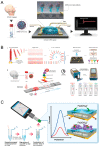State of the Art on the SARS-CoV-2 Toolkit for Antigen Detection: One Year Later
- PMID: 34562898
- PMCID: PMC8470122
- DOI: 10.3390/bios11090310
State of the Art on the SARS-CoV-2 Toolkit for Antigen Detection: One Year Later
Abstract
The recent global events of COVID-19 in 2020 have alerted the world to the risk of viruses and their impacts on human health, including their impacts in the social and economic sectors. Rapid tests are urgently required to enable antigen detection and thus to facilitate rapid and simple evaluations of contagious individuals, with the overriding goal to delimitate spread of the virus among the population. Many efforts have been achieved in recent months through the realization of novel diagnostic tools for rapid, affordable, and accurate analysis, thereby enabling prompt responses to the pandemic infection. This review reports the latest results on electrochemical and optical biosensors realized for the specific detection of SARS-CoV-2 antigens, thus providing an overview of the available diagnostics tested and marketed for SARS-CoV-2 antigens as well as their pros and cons.
Keywords: SARS-CoV-2 detection; droplets; nasopharyngeal swab; saliva; serum.
Conflict of interest statement
The authors declare no conflict of interest.
Figures





Similar articles
-
The potential application of electrochemical biosensors in the COVID-19 pandemic: A perspective on the rapid diagnostics of SARS-CoV-2.Biosens Bioelectron. 2021 Mar 15;176:112905. doi: 10.1016/j.bios.2020.112905. Epub 2020 Dec 17. Biosens Bioelectron. 2021. PMID: 33358285 Free PMC article. Review.
-
Comparison of the SARS-CoV-2 Rapid antigen test to the real star Sars-CoV-2 RT PCR kit.J Virol Methods. 2021 Feb;288:114024. doi: 10.1016/j.jviromet.2020.114024. Epub 2020 Nov 20. J Virol Methods. 2021. PMID: 33227341 Free PMC article.
-
Rapid SARS-CoV-2 antigen detection potentiates early diagnosis of COVID-19 disease.Biosci Trends. 2021 May 11;15(2):93-99. doi: 10.5582/bst.2021.01090. Epub 2021 Mar 26. Biosci Trends. 2021. PMID: 33776018
-
Performance of a rapid antigen test in the diagnosis of SARS-CoV-2 infection.J Med Virol. 2021 May;93(5):2988-2991. doi: 10.1002/jmv.26830. Epub 2021 Feb 9. J Med Virol. 2021. PMID: 33527409 Free PMC article.
-
The role of the surface ligand on the performance of electrochemical SARS-CoV-2 antigen biosensors.Anal Bioanal Chem. 2022 Jan;414(1):103-113. doi: 10.1007/s00216-020-03137-y. Epub 2021 Feb 22. Anal Bioanal Chem. 2022. PMID: 33616686 Free PMC article. Review.
Cited by
-
Molecular accuracy vs antigenic speed: SARS-CoV-2 testing strategies.Curr Opin Pharmacol. 2022 Feb;62:152-158. doi: 10.1016/j.coph.2021.12.006. Epub 2021 Dec 21. Curr Opin Pharmacol. 2022. PMID: 35042168 Free PMC article. Review.
-
Visual Detection of COVID-19 from Materials Aspect.Adv Fiber Mater. 2022;4(6):1304-1333. doi: 10.1007/s42765-022-00179-y. Epub 2022 Aug 8. Adv Fiber Mater. 2022. PMID: 35966612 Free PMC article. Review.
-
Sensitive SARS-CoV-2 detection in wastewaters using a carbon nanodot-amplified electrochemiluminescence immunosensor.Talanta. 2022 Sep 1;247:123543. doi: 10.1016/j.talanta.2022.123543. Epub 2022 May 13. Talanta. 2022. PMID: 35594835 Free PMC article.
-
Organic Electrochemical Transistor Immuno-Sensors for Spike Protein Early Detection.Biosensors (Basel). 2023 Jul 17;13(7):739. doi: 10.3390/bios13070739. Biosensors (Basel). 2023. PMID: 37504137 Free PMC article.
-
Isothermal amplification-assisted diagnostics for COVID-19.Biosens Bioelectron. 2022 Jun 1;205:114101. doi: 10.1016/j.bios.2022.114101. Epub 2022 Feb 17. Biosens Bioelectron. 2022. PMID: 35202984 Free PMC article. Review.
References
-
- Everyone Included: Social Impact of COVID-19|DISD. [(accessed on 28 June 2021)]. Available online: https://www.un.org/development/desa/dspd/everyone-included-covid-19.html/
-
- The Territorial Impact of COVID-19: Managing the Crisis Across Levels of Government. [(accessed on 28 June 2021)]. Available online: https://www.oecd.org/coronavirus/policy-responses/the-territorial-impact...
Publication types
MeSH terms
Substances
LinkOut - more resources
Full Text Sources
Other Literature Sources
Medical
Miscellaneous

